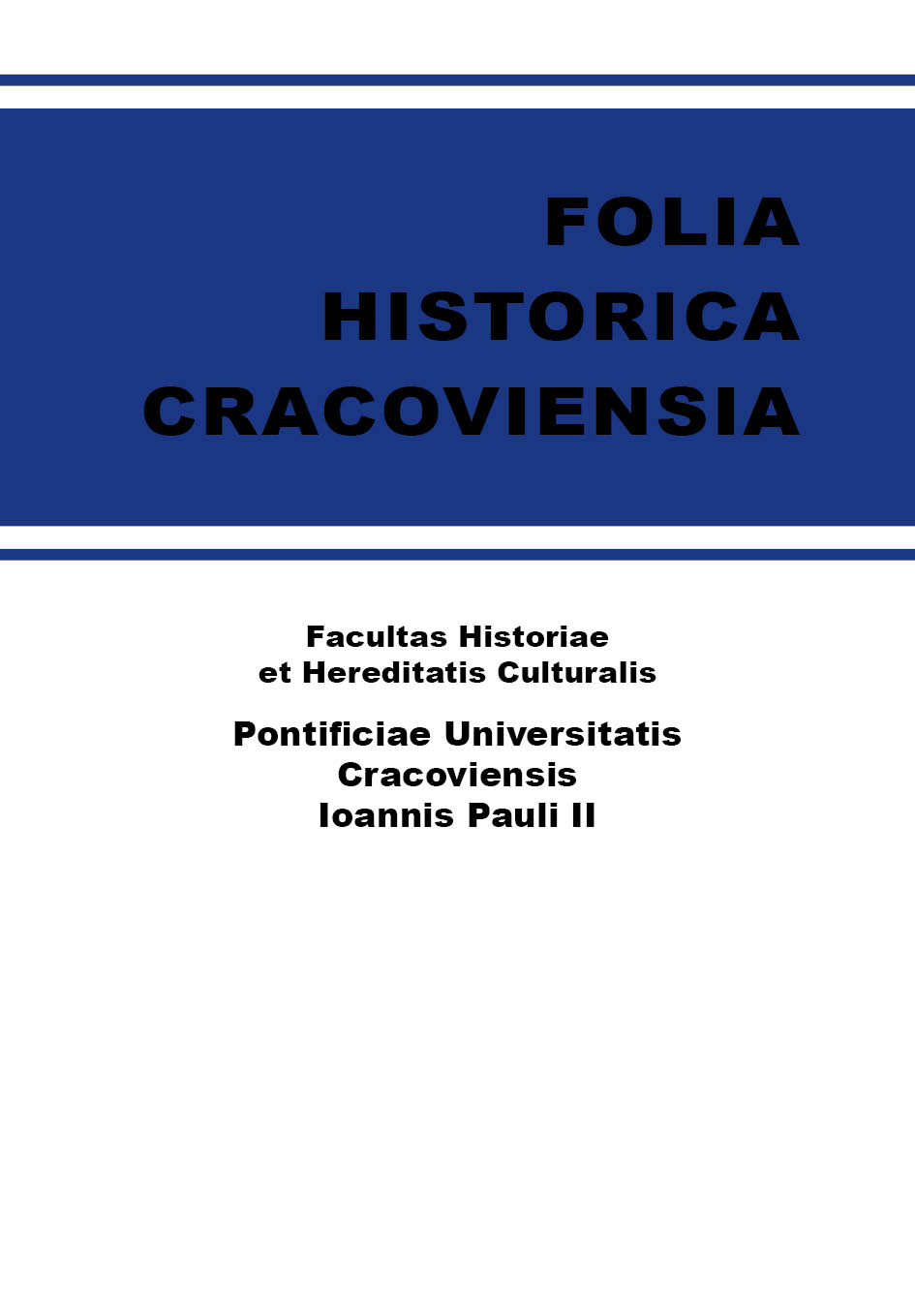Zmiany w wyposażeniu architektoniczno-rzeźbiarskim klasztoru czerwińskiego w pierwszej połowie XVI wieku
DOI:
https://doi.org/10.15633/fhc.2077Słowa kluczowe:
klasztor w Czerwińsku, rzeźba renesansowa, sakrarium, Giovanni CiniAbstrakt
Wzniesiony przed połową XII wieku kościół i klasztor Kanoników Regularnych Lateraneńskich w Czerwińsku został przebudowany w latach 1524–1538 z inicjatywy opata Jakuba Kuli. Założono wówczas sklepienia w kościele, powstała polichromia w prezbiterium i dekoracja żeber sklepiennych w refektarzu klasztornym. Okna i portale otrzymały kamienne, profilowane obramienia o formach przejściowych, gotycko-renesansowych. Z tego czasu pochodzą też, bardzo już dziś zniszczone, pozostałości kamiennej oprawy sakrarium – relikty pilastrów dekorowanych delikatnie i precyzyjnie rzeźbioną arabeską kandelabrową oraz fragment tympanonu z motywem Baranka leżącego na księdze i zbierającego krew do kielicha. W odróżnieniu od innych detali i obramień dekoracja sakrarium jest zaawansowana stylowo i bliska wzorom włoskim, znanym z Krakowa. Wysoka klasa obiektu, widoczna pomimo szczątkowego zachowania, wskazuje na biegłego artystę. Wspólne motywy ornamentów kierują naszą uwagę w stronę innego podobnego obiektu, sakrarium w Gdowie, wykonanego prawdopodobnie w drugiej ćwierci XVI wieku w warsztacie Giovanniego Cini ze Sieny, zatrudnionego wcześniej w kaplicy Zygmuntowskiej.Prace budowlane w Czerwińsku zbiegły się w czasie z budową katedry w Płocku, prowadzonej przez Bernardina de Gianotis, Giovanniego Cini i Filipa z Fiesole. W 1532 roku Cini wrócił do Polski z trzyletniego pobytu w Sienie i mógł podjąć się realizacji nowych zamówień. Niewykluczone, że opat Kula, dokonując w tym samym czasie remontu klasztoru, uwzględnił obecność Włochów w Płocku i skorzystał z ich doświadczeń w zakresie zaprojektowania wzoru, doboru motywów ornamentalnych i samego wykonania dzieła.
Bibliografia
Budka W., Działalność architektów i rzemieślników przy restauracjach katedry płockiej w wieku XVI, „Rzeczy Piękne” 5 (1925), s. 125–126.
Caspary H., Das Sakramentstabernakel in Italien bis zum Konzil von Trient. Gestalt, Ikonographie und Symbolik, kultische Funktion, München 1964.
Cercha S., Kopera F., Nadworny malarz Zygmunta Starego Giovanni Cini ze Sieny i jego dzieła w Polsce, Kraków 1916.
Chrzanowski T., Kornecki M., Sztuka ziemi krakowskiej, Kraków 1982.
Folwarski H., Poczet opatów klasztoru kanoników regularnych w Czerwińsku, „Nasza Przeszłość. Studia z Dziejów Kościoła i Kultury Katolickiej w Polsce” Kraków, 6 (1957), s. 5–81.
Katalog Zabytków Sztuki w Polsce,, t. 10: Dawne województwo warszawskie, z. 16: Płońsk i okolice, oprac. I. Galicka, H. Sygietyńska, T. Mroczko, Warszawa 1979.
Kopera F., Materiały do inwentaryzacji zabytków sztuki i kultury w Polsce. Zabytki kościoła parafialnego w Gdowie, „Wiadomości Numizmatyczno-Archeologiczne” 3 (1905) t. 63, nr 5, szp. 309–312.
Kornecki M., Zabytki sztuki, [w:] Monografia powiatu myślenickiego, cz. 1: Historia, Kraków 1970, s. 339–340.
Korpysz E., Рeнесансни кивоти в Малопольщі та на Львівщинi, [w:] Icтopiя peлiгiй в Үкpaїнi. Пpaцi XXI-ї мiжнapoдної нayкової конфepeнцiї, т. 2, Львів 2012, s. 540–552.
Korpysz E., Zmiany w sposobie przechowywania Eucharystii w świetle działalności bp. Gian Mattea Gibertiego oraz potrydenckich reform św. Karola Boromeusza i późniejszych synodów, [w:] Sztuka po Trydencie. Studia de Arte Moderna I. Studia dedykowane Prof. Adamowi Małkiewiczowi, red. K. Kuczman, ks. A. Witko, Kraków 2014, s. 39–54.
Kozakiewiczowa H., Spółka architektoniczno-rzeźbiarska Bernardina de Gianotis i Jana Cini, „Biuletyn Historii Sztuki” 21 (1959) nr 2, s. 151–174.
Mroczko T., Czerwińsk romański, Warszawa 1972.
Mroczko T., Polska sztuka przedromańska i romańska, Warszawa 1988.
Nowiński J., Ars Eucharistica. Idee, miejsca i formy towarzyszące przechowywaniu eucharystii w sztuce wczesnochrześcijańskiej i średniowiecznej, Warszawa 2000.
Nowiński J., Czerwińsk, Warszawa 2012.
Nußbaum O., Die Aufbewahrung der Eucharistie, Bonn 1979.
Polska sztuka przedromańska i romańska do schyłku XIII wieku, t. 1–2, red. M. Walicki, Warszawa 1971.
Ptaśnik J., Cracovia Artificum 1501–1550, z. 1, do druku przygot. M. Friedberg, Kraków 1936 (Źródła do Historii Sztuki i Cywilizacji w Polsce, 5).
Raible F., Der Tabernakel einst und jetzt, Freiburg im Breisgau 1908.
Szablowski J., Architektura renesansowa i manierystyczna w Polsce, Kraków 1965.
Świechowski Z., Świechowska E., Polska sztuka romańska, Warszawa 2006.
Weidenhöffer H., Sakramentshäuschen in Österreich. Eine Untersuchung zur Typologie und stilistischen Entwicklung in der Spätgotik und Renaissance, Graz 1992.
Pobrania
Opublikowane
Numer
Dział
Licencja
Autorzy publikujący w czasopiśmie udzielają jego wydawcy zgody o następującej treści:
- Autor zachowuje autorskie prawa majątkowe do utworu, a jednocześnie udziela wydawcy czasopisma zgody na jego pierwszą publikację w wersji drukowanej i wersji online na licencji Creative Commons Uznanie autorstwa 4.0 Międzynarodowe oraz zgody na wykonywanie opracowań, w tym przekładów.
- Autor ma możliwość udzielania zgody niewyłącznej na opublikowanie utworu w wersji, która ukazała się w czasopiśmie (np. zamieszczenia go w repozytorium instytucjonalnym lub opublikowania w książce), wraz z informacją o jego pierwszej publikacji w czasopiśmie.
- Autor może umieścić swój utwór online (np. w repozytorium instytucjonalnym lub na swojej stronie internetowej) jeszcze przed zgłoszeniem utworu do czasopisma.

